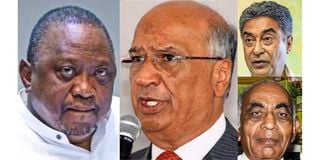Premium
Oxfam: Uhuru Kenyatta's family, four others richer than 22 million people combined

From left: Former President Uhuru Kenyatta, Sameer Africa Group Chairman Naushad Merali, CEO Bedi Investments Jaswinder Bedi and Bidco Oil Refinaries limited Chairman Bhimji Shah. A different Oxfam report in January last year listed Merali, Shah, Bedi and Kenyatta’s family as the top four richest in the country, with a combined wealth of Sh311.7 billion.
Kenya’s top four richest individuals have more wealth than nearly half of the population, a new report by the global movement on alleviation of poverty, Oxfam, has revealed.
Oxfam says the four super-rich persons — who have not been named — have a combined wealth of Sh333 billion, which is more than what 22 million poorest Kenyans (the bottom 40 per cent) own.
A different Oxfam report in January last year listed Samir Naushad Merali, Bhimji Depar Shah, Jaswinder Singh Bedi and former President Uhuru Kenyatta’s family as the top four richest in the country, with a combined wealth of Sh311.7 billion.
In the new findings that show growing economic inequalities in the country, Oxfam also revealed that Kenya’s richest 130 individuals own wealth equivalent to 70 per cent of the country’s current budget (Sh3.3 trillion), or 19 per cent of its Gross Domestic Product (GDP).
“The analysis shows that there are 1,890 individuals in Kenya with a net worth of $5 million (Sh615 million) or more, with wealth totalling $39.9 billion (Sh4.9 trillion). This also includes 130 individuals with $50 million (Sh6.15 billion) or more with a combined wealth of $18.7 billion (Sh2.3 billion),” Oxfam stated.
The 1,890 individuals, about 0.003 per cent of Kenya’s population, own wealth equivalent to 37.8 per cent of Kenya’s Sh12.09 trillion GDP by 2021.
“The analysis shows that the increasing extreme wealth of the rich and increasing extreme poverty of the poor driven by low taxes on the richest Kenyans by virtue of tax breaks, incentives, avoidance and evasion, alongside unfairly higher taxes on poorest Kenyan’s, directly through income tax and indirectly through taxes on fuel, food and basic commodities, is a social ill and a shame,” Dr John Kitui, Oxfam Kenya’s Country Director, said.
Oxfam conducted the analysis together with the Fight Inequality Alliance, Institute for Policy Studies and the Patriotic Millionaires, showing a growing level of extreme wealth in Kenya.
It showed that, in the past decade, Kenyans with a net worth of Sh615 million and above have seen their wealth grow by 72 per cent in real terms. Their population, on the other hand, has grown by 134 per cent, the analysis shows.
“Kenya super-rich are increasingly amassing enormous wealth even as most Kenyans grapple with the impact of the Covid-19 pandemic, rocketing prices of basic items, drought and unemployment,” Oxfam notes.
“The richest five individuals in Kenya are the same people ranked in the previous report but they might have gotten wealthier,” Mr Andrew Gogo, Fiscal Justice Strategist at Oxfam Kenya told the Nation yesterday.
A list of the top five richest individuals in the country, according to data from WealtX, includes Mr Merali, Mr Shah, Mr Bedi, Mr Kenyatta and Mr Mahendra Nanji Mehta with a combined wealth valued at $3.2 billion.
The details reveal the growing economic inequalities, with millions of Kenyans across half of the country facing acute hunger.
Drought crisis
The latest report from National Drought Management Authority (NDMA) shows that the drought situation remains critical in 22 of the 23 counties classified as arid and semi-arid lands (Asals) due to delayed and poor performance of the October- December 2022 short rains, coupled with four previous consecutive failed rainfall seasons.
NDMA in the January update said Asal counties — Kilifi, Mandera, Marsabit, Samburu, Turkana, Wajir, Isiolo, Kitui and Kajiado — are in alarm drought phase while 13 counties, including Garissa, Lamu, Narok, Tana River, Makueni, Tharaka Nithi, Baringo, Laikipia and Meru, are in Alert drought phase.
“We have noted that Marsabit, Mandera, Garissa, Baringo and Isiolo counties have high rates of children at risk of malnutrition. The long rains assessment conducted in July 2022 had projected that 4.35 million people would require relief assistance by December,” noted NDMA.
Recent reports by at least four public and private organisations showed that six counties hosting 10 million Kenyans are at risk of acute hunger this year, extending the ravaging situation witnessed through 2022.






